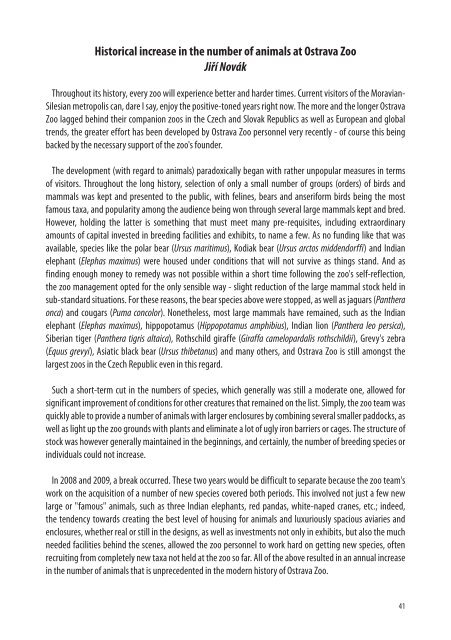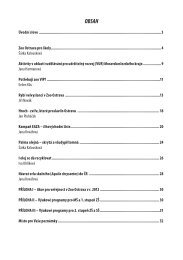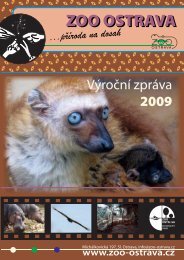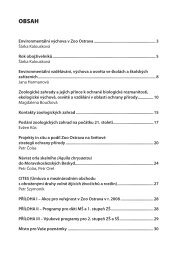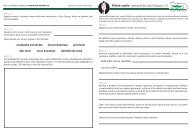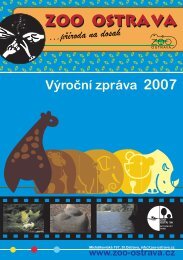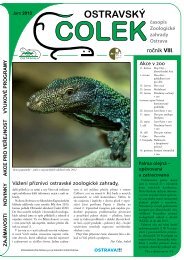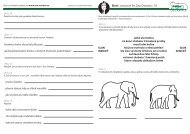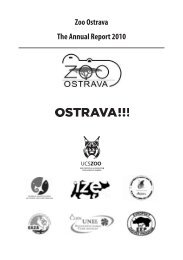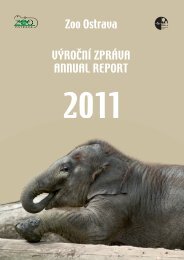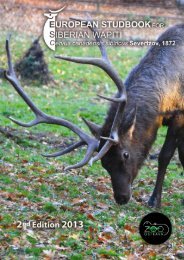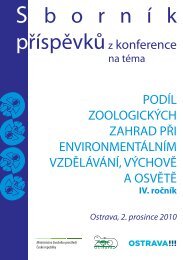Create successful ePaper yourself
Turn your PDF publications into a flip-book with our unique Google optimized e-Paper software.
Historical increase in the number of animals at <strong>Ostrava</strong> <strong>Zoo</strong><br />
Jiří Novák<br />
Throughout its history, every zoo will experience better and harder times. Current visitors of the Moravian-<br />
Silesian metropolis can, dare I say, enjoy the positive-toned years right now. <strong>The</strong> more and the longer <strong>Ostrava</strong><br />
<strong>Zoo</strong> lagged behind their companion zoos in the Czech and Slovak Republics as well as European and global<br />
trends, the greater effort has been developed by <strong>Ostrava</strong> <strong>Zoo</strong> personnel very recently - of course this being<br />
backed by the necessary support of the zoo's founder.<br />
<strong>The</strong> development (with regard to animals) paradoxically began with rather unpopular measures in terms<br />
of visitors. Throughout the long history, selection of only a small number of groups (orders) of birds and<br />
mammals was kept and presented to the public, with felines, bears and anseriform birds being the most<br />
famous taxa, and popularity among the audience being won through several large mammals kept and bred.<br />
However, holding the latter is something that must meet many pre-requisites, including extraordinary<br />
amounts of capital invested in breeding facilities and exhibits, to name a few. As no funding like that was<br />
available, species like the polar bear (Ursus maritimus), Kodiak bear (Ursus arctos middendorffi) and Indian<br />
elephant (Elephas maximus) were housed under conditions that will not survive as things stand. And as<br />
finding enough money to remedy was not possible within a short time following the zoo's self-reflection,<br />
the zoo management opted for the only sensible way - slight reduction of the large mammal stock held in<br />
sub-standard situations. For these reasons, the bear species above were stopped, as well as jaguars (Panthera<br />
onca) and cougars (Puma concolor). Nonetheless, most large mammals have remained, such as the Indian<br />
elephant (Elephas maximus), hippopotamus (Hippopotamus amphibius), Indian lion (Panthera leo persica),<br />
Siberian tiger (Panthera tigris altaica), Rothschild giraffe (Giraffa camelopardalis rothschildii), Grevy's zebra<br />
(Equus grevyi), Asiatic black bear (Ursus thibetanus) and many others, and <strong>Ostrava</strong> <strong>Zoo</strong> is still amongst the<br />
largest zoos in the Czech Republic even in this regard.<br />
Such a short-term cut in the numbers of species, which generally was still a moderate one, allowed for<br />
significant improvement of conditions for other creatures that remained on the list. Simply, the zoo team was<br />
quickly able to provide a number of animals with larger enclosures by combining several smaller paddocks, as<br />
well as light up the zoo grounds with plants and eliminate a lot of ugly iron barriers or cages. <strong>The</strong> structure of<br />
stock was however generally maintained in the beginnings, and certainly, the number of breeding species or<br />
individuals could not increase.<br />
In 2008 and <strong>2009</strong>, a break occurred. <strong>The</strong>se two years would be difficult to separate because the zoo team's<br />
work on the acquisition of a number of new species covered both periods. This involved not just a few new<br />
large or "famous" animals, such as three Indian elephants, red pandas, white-naped cranes, etc.; indeed,<br />
the tendency towards creating the best level of housing for animals and luxuriously spacious aviaries and<br />
enclosures, whether real or still in the designs, as well as investments not only in exhibits, but also the much<br />
needed facilities behind the scenes, allowed the zoo personnel to work hard on getting new species, often<br />
recruiting from completely new taxa not held at the zoo so far. All of the above resulted in an annual increase<br />
in the number of animals that is unprecedented in the modern history of <strong>Ostrava</strong> <strong>Zoo</strong>.<br />
41


